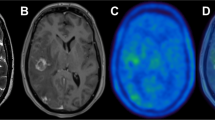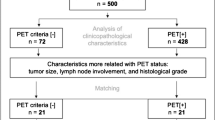Abstract
Objective
To assess whether integrated fluorodeoxyglucose positron emission tomography/computed tomography (FDG-PET/CT) can improve the diagnostic accuracy of metastatic regional lymph nodes (LNs) in esophageal cancer compared with contrast enhanced CT (CECT).
Methods
We examined 180 consecutive patients with esophageal cancer by integrated PET/CT between April 2006 and March 2007. Eighteen patients (M:F 14:4) underwent radical esophagectomy after evaluations by PET/CT and CECT of 5–7-mm-thick slices 70–80 s after injection. Regional LNs of esophageal cancer were retrospectively reviewed on CECT images by two blinded evaluators on the basis of the following cutoff sizes: 7 mm for all regional LNs (Protocol A), 10 mm for paratracheal LNs (Protocol B), and 7 mm for others. In addition, the maximum standardized uptake value (SUVmax) on PET/CT was evaluated for positive uptake by LNs.
Results
Of 210 LNs excised at surgery, 25 were positive and 185 were negative for metastasis at pathology. The PET/CT images identified 15 true-positive and 184 truenegative LNs, whereas CECT identified 15 true positives and 176 true negatives in Protocol A, and 14 true positives and 180 true negative in Protocol B. The sensitivity, specificity, accuracy, positive, and negative predictive values of PET/CT were respectively 60.0%, 99.5%, 94.8%, 93.8%, and 94.8%, whereas those of CECT were 60.0%, 95.1%, 91.0%, 62.5%, and 94.6% (Protocol A) and 56.0%, 97.3%, 92.4%, 73.7%, and 94.2% (Protocol B). A comparison of the two CECT protocols revealed fewer false-positive LNs in Protocol B, but slightly lower sensitivity in Protocol B than in Protocol A. Substantial numbers of false-positive LNs were determined by CECT in the paratracheal regions (6 of 9, 66.7%) and CECT revealed central necrosis in 4 of 15 (26.7%) true-positive LNs > 1.8 cm. The mean SUVmax on PET/CT was 2.9 (range 1.7–5.5) in true-positive LNs. The smallest LN metastasis detectable by PET/CT was 6 mm.
Conclusions
Integrated PET/CT improves the PPV of regional LNs when compared with CECT.
Similar content being viewed by others
References
Jemal A, Siegel R, Ward E, Murray T, Xu J, Thun MJ. Cancer statistics. CA Cancer J Clin 2007;57:43–66.
Buenaventura P, Luketich JD. Surgical staging of esophageal cancer. Chest Surg Clin N Am 2000;10:487–497.
Sugimachi K, Ikebe M, Kitamura K, Toh Y, Matsuda H, Kuwano H. Long-term results of esophagectomy for early esophageal carcinoma. Hepatogastroenterology 1993;40:203–206.
Rice TW, Zuccaro G Jr, Adelstein DJ, Rybicki LA, Blackstone EH, Goldblum JR. Esophageal carcinoma: depth of tumor invasion is predictive of regional lymph node status. Ann Thorac Surg 1998;65:787–792.
Dhar DK, Hattori S, Tonomoto Y, Shimoda T, Kato H, Tachibana M, et al. Appraisal of a revised lymph node classification system for esophageal squamous cell cancer. Ann Thorac Surg 2007;83:1265–1272.
Luketich JD, Meehan M, Nguyen NT, Christie N, Weigel T, Yousem S, et al. Minimally invasive surgical staging for esophageal cancer. Surg Endosc 2000;14:700–702.
Gore RM. Upper gastrointestinal tract tumours: diagnosis and staging strategies. Cancer Imaging 2005;5:95–98.
Ott K, Weber W, Siewert JR. The importance of PET in the diagnosis and response evaluation of esophageal cancer. Dis Esophagus 2006;19:433–442.
Flanagan FL, Dehdashti F, Siegel BA, Trask DD, Sundaresan SR, Patterson GA, et al. Staging of esophageal cancer with 18F-fluorodeoxyglucose positron emission tomography. AJR Am J Roentgenol 1997;168:417–424.
Yeung HW, Macapinlac HA, Mazumdar M, Bains M, Finn RD, Larson SM. FDG-PET in esophageal cancer: incremental value over computed tomography. Clin Positron Imaging 1999;2:255–260.
Duong CP, Demitriou H, Weih L, Thompson A, Williams D, Thomas RJ, et al. Significant clinical impact and prognostic stratification provided by FDG-PET in the staging of oesophageal cancer. Eur J Nucl Med Mol Imaging 2006;33:759–769.
Bar-Shalom R, Guralnik L, Tsalic M, Leiderman M, Frenkel A, Gaitini D, et al. The additional value of PET/CT over PET in FDG imaging of oesophageal cancer. Eur J Nucl Med Mol Imaging 2005;32:918–924.
Japanese Society for Esophageal Diseases. Guidelines for the clinical and pathologic studies on carcinoma of the esophagus [in Japanese], 10th ed. Tokyo: Kanehara Shuppan; 2007.
Beck JR. Likelihood ratios: another enhancement of sensitivity and specificity. Arch Pathol Lab Med 1986;110:685–686.
Luketich JD, Schauer PR, Meltzer CC, Landreneau RJ, Urso GK, Townsend DW, et al. Role of positron emission tomography in staging esophageal cancer. Ann Thorac Surg 1997;64:765–769.
Rankin SC, Taylor H, Cook GJ, Mason R. Computed tomography and positron emission tomography in the pre-operative staging of oesophageal carcinoma. Clin Radiol 1998;53:659–665.
Choi JY, Lee KH, Shim YM, Lee KS, Kim JJ, Kim SE, et al. Improved detection of individual nodal involvement in squamous cell carcinoma of the esophagus by FDG PET. J Nucl Med 2000;41:808–815.
Yoon YC, Lee KS, Shim YM, Kim BT, Kim K, Kim TS. Metastasis to regional lymph nodes in patients with esophageal squamous cell carcinoma: CT versus FDG PET for presurgical detection prospective study. Radiology 2003;227:764–770.
Kato H, Kuwano H, Nakajima M, Miyazaki T, Yoshikawa M, Ojima H, et al. Comparison between positron emission tomography and computed tomography in the use of the assessment of esophageal carcinoma. Cancer 2002;94:921–928.
Luketich JD, Friedman DM, Weigel TL, Meehan MA, Keenan RJ, Townsend DW, et al. Evaluation of distant metastases in esophageal cancer: 100 consecutive positron emission tomography scans. Ann Thorac Surg 1999;68:1133–1136; discussion 1136–7.
Lerut T, Flamen P, Ectors N, Van Cutsem E, Peeters M, Hiele M, et al. Histopathologic validation of lymph node staging with FDG-PET scan in cancer of the esophagus and gastroesophageal junction: a prospective study based on primary surgery with extensive lymphadenectomy. Ann Surg 2000;232:743–752.
Fukunaga T, Okazumi S, Koide Y, Isono K, Imazeki K. Evaluation of esophageal cancers using fluorine-18-fluorodeoxyglucose PET. J Nucl Med 1998;39:1002–1007.
Kato H, Miyazaki T, Nakajima M, Takita J, Kimura H, Faried A, et al. The incremental effect of positron emission tomography on diagnostic accuracy in the initial staging of esophageal carcinoma. Cancer 2005;103:148–156.
Lowe VJ, DeLong DM, Hoffman JM, Coleman RE. Optimum scanning protocol for FDG-PET evaluation of pulmonary malignancy. J Nucl Med 1995;36:883–887.
Nakamoto Y, Higashi T, Sakahara H, Tamaki N, Kogire M, Doi R, et al. Delayed (18)F-fluoro-2-deoxy-D-glucose positron emission tomography scan for differentiation between malignant and benign lesions in the pancreas. Cancer 2000;89:2547–2554.
Boerner AR, Weckesser M, Herzog H, Schmitz T, Audretsch W, Nitz U, et al. Optimal scan time for fluorine-18 fluorodeoxyglucose positron emission tomography in breast cancer. Eur J Nucl Med 1999;26:226–230.
Yamada S, Kubota K, Kubota R, Ido T, Tamahashi N. High accumulation of fluorine-18-fluorodeoxyglucose in turpentine-induced inflammatory tissue. J Nucl Med 1995;36:1301–1306.
Kubota K, Itoh M, Ozaki K, Ono S, Tashiro M, Yamaguchi K, et al. Advantage of delayed whole-body FDG-PET imaging for tumour detection. Eur J Nucl Med 2001;28:696–703.
Author information
Authors and Affiliations
Corresponding author
Rights and permissions
About this article
Cite this article
Okada, M., Murakami, T., Kumano, S. et al. Integrated FDG-PET/CT compared with intravenous contrast-enhanced CT for evaluation of metastatic regional lymph nodes in patients with resectable early stage esophageal cancer. Ann Nucl Med 23, 73–80 (2009). https://doi.org/10.1007/s12149-008-0209-1
Received:
Accepted:
Published:
Issue Date:
DOI: https://doi.org/10.1007/s12149-008-0209-1




